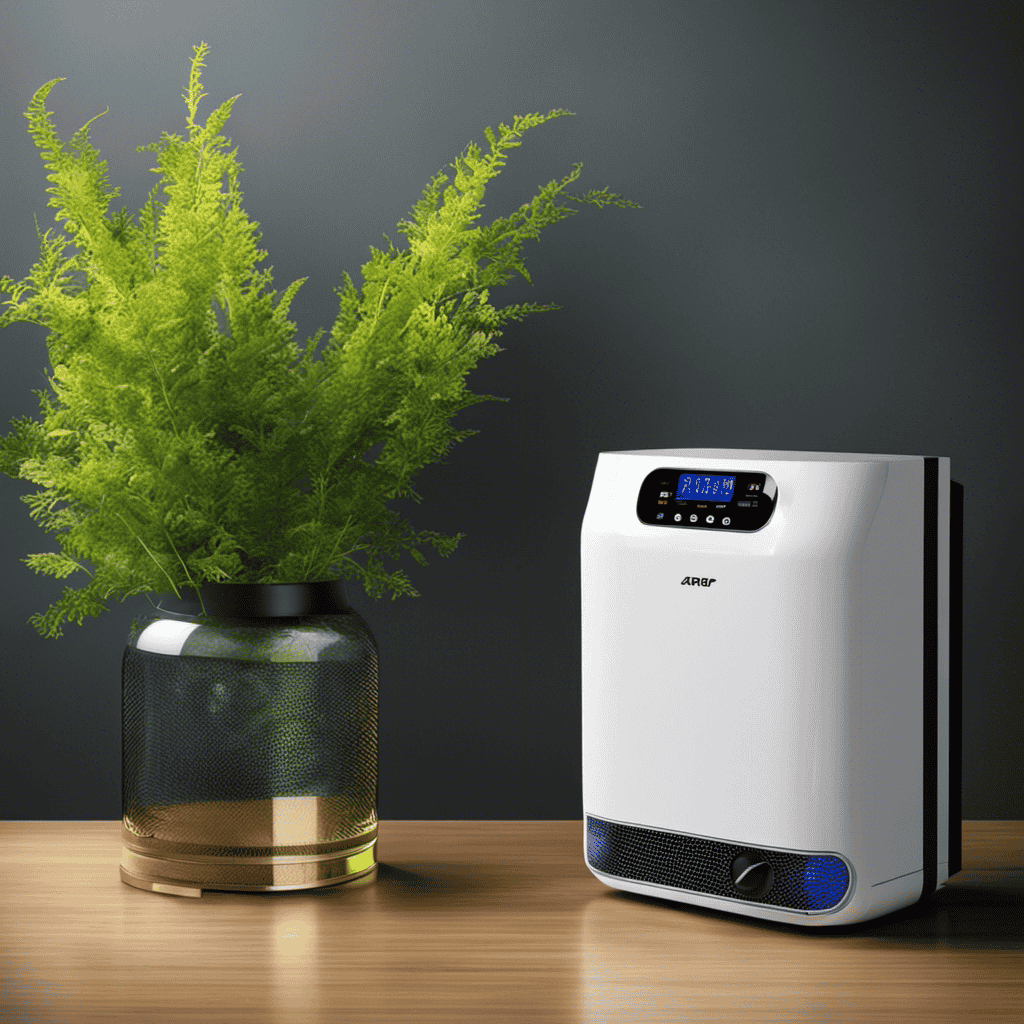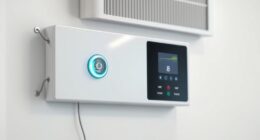I’ve been grappling with bad air quality in my house for some time. It’s impacting my well-being, and I’m aware that I require an air purifier to address the issue.
But with so many options out there, I’m left wondering, what type of air purifier do I need? In this article, I’ll break down the different types of air pollutants, factors to consider when choosing a purifier, and the benefits of HEPA and activated carbon filters.
Get ready to breathe easier with the right air purifier for your needs.
Key Takeaways
- Common indoor pollutants include dust, pollen, pet dander, VOCs, and formaldehyde.
- HEPA filters are effective at removing small particles like dust and pollen.
- Activated carbon filters excel at removing odors, gases, and VOCs.
- Proper placement of the air purifier is crucial for optimal performance.
Understanding Different Types of Air Pollutants
To understand the different types of air pollutants, you’ll need to know what specific contaminants you want your air purifier to target.
Common indoor pollutants include particles such as dust, pollen, and pet dander, as well as gases like volatile organic compounds (VOCs) and formaldehyde. These pollutants can have detrimental effects on our health.
For instance, exposure to particulate matter can cause respiratory issues and worsen allergies. VOCs, commonly found in cleaning products and building materials, can lead to eye, nose, and throat irritation, as well as long-term health effects such as liver and kidney damage. Formaldehyde, a common indoor pollutant, is a known carcinogen and can cause respiratory and skin irritation.
Therefore, it is essential to choose an air purifier that effectively targets the specific contaminants present in your indoor environment to ensure a healthy living space.
Factors to Consider When Choosing an Air Purifier
When choosing an air purifier, it’s important to consider factors such as size, filtration system, and noise level. These factors can greatly affect the efficiency and effectiveness of the air purifier in improving indoor air quality. Here are four key considerations to keep in mind:
-
Size: The size of the air purifier should be appropriate for the room or area you want to purify. A smaller purifier may not be able to effectively clean the air in a larger space, while a larger purifier may be unnecessary for a small room.
-
Filtration System: Look for air purifiers that use HEPA filters, as they are highly efficient in capturing small particles like dust, pollen, and pet dander. Some purifiers also have additional filters for removing odors and volatile organic compounds (VOCs).
-
Noise Level: Consider the noise level of the air purifier, especially if you plan to use it in a bedroom or office. Look for purifiers with adjustable fan speeds or quiet modes to ensure a peaceful environment.
-
Cost Considerations: Compare prices of different air purifier brands and models, taking into account not only the initial cost but also the cost of replacement filters. Some purifiers may have higher upfront costs but lower maintenance costs in the long run.
HEPA Vs. Activated Carbon: Which Filter Is Right for You
Consider the benefits of both HEPA and activated carbon filters when choosing the right filter for you.
HEPA filters are highly effective at removing small particles from the air, such as dust, pollen, and pet dander. They have a high efficiency rate, capturing up to 99.97% of particles as small as 0.3 microns.
On the other hand, activated carbon filters excel at removing odors, gases, and volatile organic compounds (VOCs) from the air. They work through a process called adsorption, where the carbon particles trap and hold these pollutants. However, it’s important to note that activated carbon filters may not be as effective in removing larger particles or allergens.
Therefore, when making a decision between HEPA and activated carbon filters, it’s crucial to consider your specific needs and the pollutants you want to target.
Transitioning into the next section, evaluating air purifier size and coverage area is also essential to ensure optimal performance and clean air in your space.
Evaluating Air Purifier Size and Coverage Area
Assessing the size and coverage area of an air purifier is crucial for ensuring it effectively cleans the air in your space. When evaluating air purifier performance, consider the following factors:
-
Room size: Determine the square footage of the room where you plan to place the air purifier. Different models are designed to handle different room sizes, so it’s important to choose one that matches your needs.
-
Clean air delivery rate (CADR): Look for the CADR rating, which indicates the volume of clean air produced by the purifier. Higher CADR values mean the purifier can clean the air more efficiently.
-
Air changes per hour (ACH): ACH represents how many times the purifier can exchange the air in a room in one hour. Higher ACH values ensure better air quality.
-
Placement: Proper placement of the air purifier is crucial for optimal performance. Avoid obstructing the air intake or exhaust vents, and keep it away from walls and furniture.
By carefully evaluating these factors, you can select an air purifier that effectively cleans the air in your space.
In the next section, we will explore the importance of finding a quiet air purifier for your home.
Noise Levels: Finding a Quiet Air Purifier for Your Home
Finding a quiet air purifier for your home is essential if you want to minimize noise disruptions. When choosing an air purifier, it’s important to consider the sound levels it produces during operation. Look for models that offer quiet operation, typically measured in decibels (dB). To help you make an informed decision, I’ve created a table comparing the sound levels of different air purifiers:
| Air Purifier Model | Sound Level (dB) |
|---|---|
| Model A | 30 dB |
| Model B | 35 dB |
| Model C | 40 dB |
| Model D | 45 dB |
As you can see, Model A has the quietest operation at 30 dB, while Model D produces a slightly higher sound level at 45 dB. Consider your noise tolerance and the location where the air purifier will be placed to choose a model that suits your needs for quiet operation.
Energy Efficiency: Saving Money and the Environment
To save money and reduce your environmental impact, look for an energy-efficient air purifier. Here are four energy saving techniques to consider when choosing an eco-friendly air purifier:
-
Energy Star certified: Look for the Energy Star label on air purifiers. These models meet strict energy efficiency guidelines set by the Environmental Protection Agency (EPA). They consume less energy and can save you money on your electricity bills.
-
Adjustable fan speeds: Opt for an air purifier with adjustable fan speeds. This allows you to customize the airflow according to your needs. Lower fan speeds consume less energy while still providing adequate air purification.
-
Timer function: Some air purifiers come with a timer function that allows you to schedule their operation. This can help you save energy by running the purifier only when needed, such as during peak pollution hours or when you’re at home.
-
Filter replacement indicator: A filter replacement indicator is a handy feature that notifies you when it’s time to change the filters. By replacing the filters on time, you ensure optimal performance and energy efficiency.
Maintenance and Filter Replacement: Keeping Your Air Purifier Running Smoothly
Regular maintenance is essential for keeping your air purifier running smoothly and ensuring optimal performance. By following a few simple maintenance tips, you can extend the lifespan of your air purifier’s filters and keep the air in your home clean and healthy.
First, it’s important to clean or replace the filters regularly. This will prevent the buildup of dust and allergens, ensuring that your air purifier continues to effectively remove pollutants from the air.
Additionally, make sure to clean the exterior of the unit to remove any dust or debris that may have accumulated.
Lastly, be sure to check the manufacturer’s instructions for specific maintenance recommendations, as different air purifiers may have different requirements.
Frequently Asked Questions
Can an Air Purifier Eliminate All Types of Air Pollutants?
Yes, an air purifier can eliminate many types of air pollutants, including viruses and bacteria. However, it’s important to note that there may be some side effects associated with using an air purifier.
Is It Necessary to Have Multiple Air Purifiers in Different Rooms of My House?
It’s necessary to have multiple air purifiers in different rooms for effective air purification. They can be cost-effective options and provide benefits like cleaner air, reduced allergies, and better sleep in the bedroom.
Can an Air Purifier Help With Allergies and Asthma?
Yes, an air purifier can help with allergies and asthma. Studies show that air purifiers are effective in reducing indoor allergens and can play a role in managing respiratory symptoms in allergic individuals.
What Is the Average Lifespan of an Air Purifier?
The average lifespan of an air purifier depends on various factors such as the quality of the device and how well it is maintained. Regular cleaning and filter replacement can extend its lifespan.
How Often Should I Replace the Filters in My Air Purifier?
I replace the filters in my air purifier regularly to ensure optimal performance and clean air. Proper air purifier maintenance, including clean filters, is crucial for removing pollutants and improving indoor air quality.
Conclusion
In conclusion, choosing the right air purifier is crucial for maintaining clean and healthy indoor air. By understanding the different types of air pollutants and considering factors such as filter type, size, noise levels, energy efficiency, and maintenance, you can find the perfect air purifier for your needs.
Just like a ship sailing through rough waters, a well-chosen air purifier will navigate through the sea of pollutants, ensuring that you and your loved ones breathe in nothing but fresh and pure air.
So, set sail on the journey towards cleaner air today!










